Brooklyn class cruisers (1936)
 USA (1936-37)
USA (1936-37)
USS Brooklyn, Philadelphia, Savannah, Nashville, Phoenix, Boise, Honolulu, St Louis, Helena.
The Brooklyns: Defining a new standard in US cruisers
It seems strange to consider some of the numerous cuiser classes that preceded WW2 or went through the war, some were more famous than others. The Pensacola “opened the ball”, the Northampton/Porltand were merely improvements, the New orleans were mostly known (sadly) for their sacrifice at Guadalcanal, and the Cleveland, Atlanta and Baltimore, mass-produced WW2 battlehorses.

Profile USS Brooklyn off Mare Island NyD 1942 -Cdts. navsource.org
But the Brooklyns defined a brand new standard in term of cruiser developement, paving the way for the future Clevelands, Whichita or Worcester, the most obvious part being the very specific straight hull and almost squared stem. For the rest, this was an incremental step with a new 5×3 light main artillery arrangement, the London treay’s infamous “heavy light cruiser”, or heavy cruisers fitted with a massive light cruiser artillery.
Another note was their relatively quiet career during WW2, despite the fact they operated on all fronts, from the Atlantic to the Mediterranean and Pacific. Despite the fact several were battle-damaged, none was sunk, and three served long after the war with Brazil, Chile and Argentine, which was the only one sunk of the whole class, under another name: General Belgrano, 1982.
Development of the Brooklyns
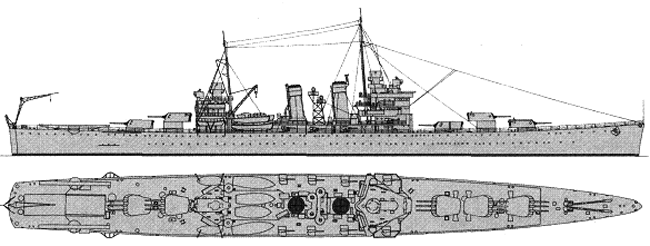
Brooklyn 1936, 2 views scheme 1937
The Brooklyns were a kind of UFO in US Naval nomenclature yet. They were considered light cruisers, and namely replacement for the 1920s Omaha class. Yet, they had nothing in common. In displacement, they displaced two times more, their armament was entirely in axial triple turrets and they had many other features that has nothing to do with the Omaha.
Yet, only ten years separated the last of the Omaha cruiser (1925) and laying down the keel of the first ship, USS Brooklyn (CL-40). In these ten years, four classes of heavy cruisers were built: The Pensacola, Northampton, Portland and New orleans, which were only considered “heavy” because of their heavy armament, three or four triple or double 8-in guns turrets. In displacement, the New Orleans (1933) displaced 9,950 long tons standard, whereas the Brooklyn were barely lighter at 9,767 long tons.
So what happened ?
The Treaty of London
Through this naval treaty, ten years after the famous Washington Treaty that defined the fleets of the interwar -and thus those of ww2- the treaty of london of 1930 limited the construction of “heavy cruisers” with calibers precisely defined between 6.1 and 8 inches (155 and 203 mm). This was in the hope for Great Britain to keep control of her trade via tailored cruisers that can still match a smaller generation cruisers in the order of a 6,000-to-8,000-tonnage, all in the wake of economical crisis following the previous’s yer fateful crash.

6-in 10,000 tons preliminary design 22 January 1932
The US agreed and the new American light cruiser design was under Admiral William V. Pratt scrutiny and at first through the General Board, objected these clauses. Nevertheless the US were allowed 180,000 long tons available for 18 heavy cruisers and 143,500 long tons (145,803 t) for light cruisers, without precision for the number of ships (potentially 14 and up to 20 cruisers). The USN policy then required large cruisers in order to deal with the very long ranges of the Pacific Ocean.
Therefore rather to built more 5000-8000 ton cruisers fit for the Mediterranean or the Baltic, large ships armed with 6-inch (150 mm) guns were chosed. This led to the design of a 10,000 long tons cruiser. Another argument in favor of this new design was the huge disappointment that were the Omaha class. All hoped the new large hull would bring the desired stability.
Design of the Brooklyn
Design studies started right when the treaty was signed in 1930. The blueprints were approved by the Congress and the first four ordered in 1933. The Congress the next year allowed three additional ships. Specifications were rather scarce, only that speed and range must match heavy cruisers. They evolved when the Japanese Mogami class appeared, and it was specified than at least fifteen 6-inch main guns must be placed. The design overviewed many combinations of armor and machinery in order to stay below the 10,000 ton limit.
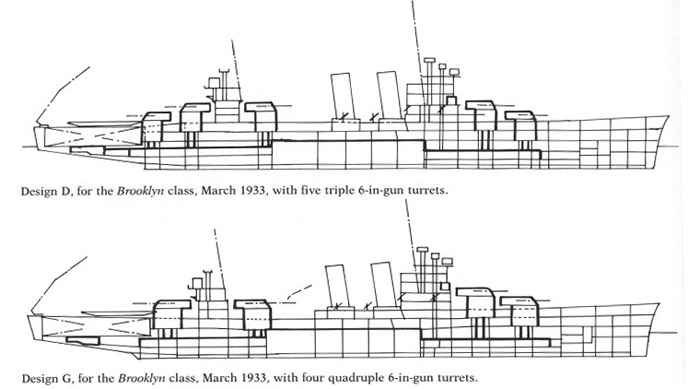
Brooklyn class preliminary designs – March 1933
The biggest end result was the revised hull form and all aviation facilities moved to the stern of the ship. This was perhaps the most clever move. Indeed, until the, reconnaissance floatplanes had been carried on catapults and cranes placed alongside the central portion of the hull. This proved later a hinderance to achieve the best arc of fire for AA weaponry, a vital concern during the pacific war that nobody predicted at that time. The same year indeed, a generation of relatively similar cruisers appeared: following the Mogami (1932), the “Town” class (1936), La Galissonniere (1934) and Duca Degli Abruzzi (1937) flirted with 10,000 tons.
Design of the Brooklyns
The design process was a long and tiedous affair: At first, the Congress repeatedly delayed construction of the light new treaty cruisers until plans elaborated by the General Board for a balanced twelve guns cruiser. But this design was refused in early 1933 as it was feared that the new 6-in and 8-in shells negated the value of armour for the intended cruiser, and the Mogami designed announced by Japan. The next two designs scheme D (triple turrets) and G (quadruple turrets) out in March 1933 were refined while scheme C four quadruple turrets and unbroken deck was retaken for the hull. At last the scheme E presented five triple turrets with the three forward in superfiring positions. Scheme A and B were earlier twelve gun studies derived from New Orleans with Scheme B integrating aicrafts facilities.
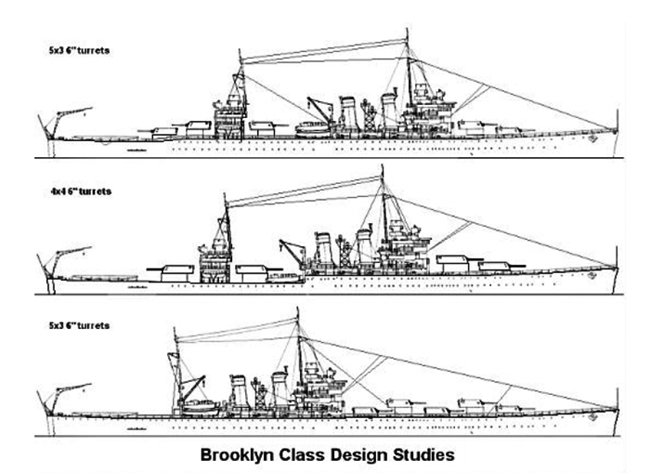
Reconstitution of preliminary designs of 1933
On 23/24 March 1933 Admiral Watson’s design to the General Board was considered, with concentrated firepower forward and dealing with blast effects and no fire control station aft. This design was modified with one turret moved aft. At last Scheme J showed a four quadruple turrets arrangement with three forward and one aft. Scheme H revered to three triple turrets forward and two aft while the deck dipped down the stern, perhaps influenced by Japanese design. The design was not popular, as it seemed vulnerable against direct fire from 8-in cruisers. There were proposals to sacrifice one turret to add protection, but they were rejected, because of immunity zone extreme range concerns.
In April 1933, the design was further modified with a hangar housing six aircraft. However protection was improved, but still not immmune from heavy cruisers. Weight reductions and structural stress balance ended with an immunity zone against 6-in shells to 8,000-23,000 yards at 60° angle. In July 1933 the hull was raised and made straight, and shorter at 600 feet rather than 612 feet while the powerplant was to provide 100,000 shp, enough for a designed 32.5 knots top speed.
Armour protection
The Brooklyn’s Main Belt at Machinery level was 5 in (127 mm) thick, based on a 0.625-inch (16 mm) STS plate, and in front of the magazines, 2 in (51 mm) on a 0.625-inch STS plate. The decks was 2 in thick, barbettes were 6 in (152 mm) thick, while the main Gun turrets were protected by 6.5 in (165 mm) on their front plate, 1.25 in (31.75 mm) on the sides and 2 in on their roofs. The conning tower had 5 in walls (127 mm).
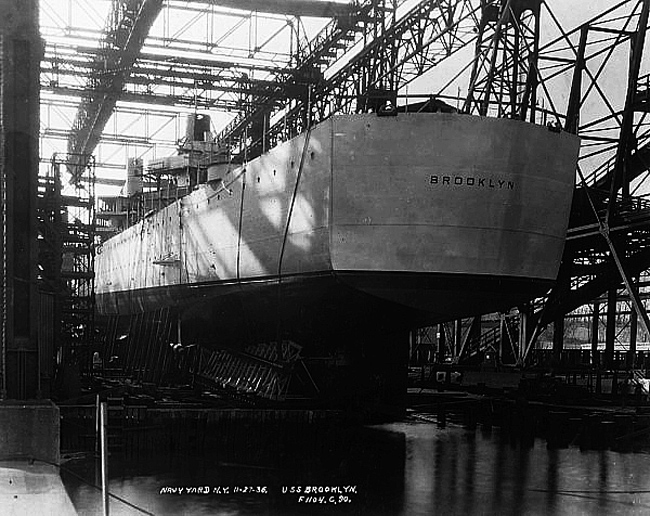
USS Brooklyn in construction, stern view showing its rounded shape, not yet “squared”. Shipyard archive – Credits navsource.org
Powerplant
These ships were 9,767 long tons (9,924 t) standard and 12,207 long tons (12,403 t) fully loaded 606 ft (185 m) overall. In size, they were 62 ft (19 m) in width (about 1/10 ratio) and had a draught about 23 ft (7.0 m). The Brooklyns were given four Parsons geared turbines on four shafts, fed by eight Babcock & Wilcox boilers for a total as designed of 100,000 shp (74,570 kW). This was enough for the designed speed of 32.5 knots (60.2 km/h; 37.4 mph), and the intended 10,000 nmi (19,000 km; 12,000 mi) range at 15 knots (28 km/h; 17 mph). Savannah and Honolulu were rebuilt after battle damage with a bulged hull increasing their beam by nearly 8 feet (2.4 m).
Main artillery
The Brooklyn artillery was composed of fifteen (5×3) 6-in/47 caliber Mark 16 naval guns. This mode was developed from the 6-in/53 Mark 8 already in use on the Omaha-class cruiser. By specification the new model and its mounting were designed to reach ten rounds per minute as a sustained rate of fire, a full volley of 150 rounds a minute as to destroy “soft” targets such as the superstructure of an enemy ship. The five turrets arrangement as shown above was axial, with three forward turret, the first two ij superfiring positions and the third one in reverse (pointing towards the bridge) as on the IJN Takao class cruisers.
The three guns however were mounted on a single mount, therefore they cannon elevate independantly. The Mark 16 standard issue ammunition was the 130-pound (59-kilogram) AP shell capable of a 26,100 yards (23,866 m) maximal range. Thanks to an semi-fixed additional charge, refined shape and slightly longer barrel, it had twice the penetration power of the Mark 8. The first trials of the gun against steel plates changed the General Board’s view of light cruisers.
Secondary and AA artillery
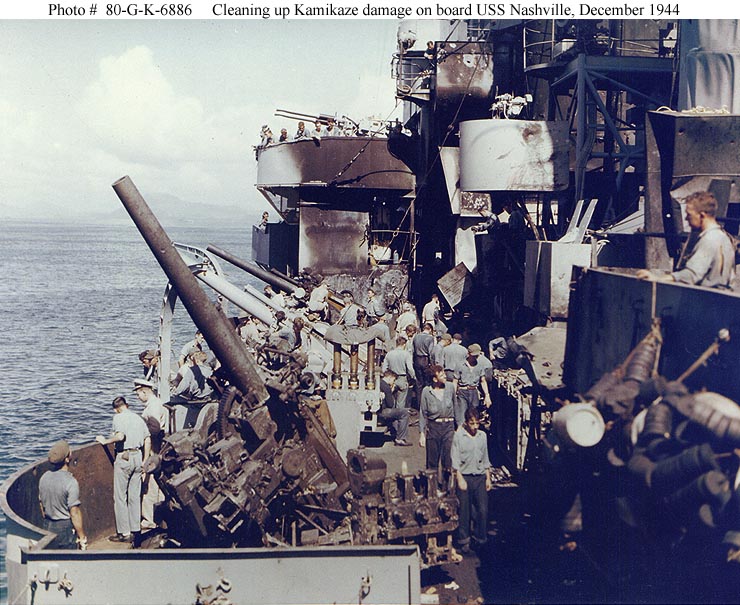
USS Nashville’s 5-in guns AA battery
The secondary armament comprised eight 5-inch (130 mm)/25 as dual-purpose single mounts mounted on the sides, completed by an AA armament of eight .50 inches (12.7 mm) M2 Browning machine guns. There was already a requirement for an 1.1-inch (27.9 mm)/75 AA gun which was never fulfilled before 1943 as this intermediate gun was prone to frequent jamming and was quite heavy. In time, 5-in/38 guns were installed on the latter ships rather than the initial 5-in/25 guns. During the war of course about twenty single 20 mm Oerlikon and multiple 40 mm (1.6 in) Bofors quad mountings were installed, generally 28 (4 × 4, 6 × 2). After battle damage Savannah and Honolulu were rebuilt and their 5-inch guns were reinstalled as four twins. This delayed however Honolulu to return into service before the end of hostilities.
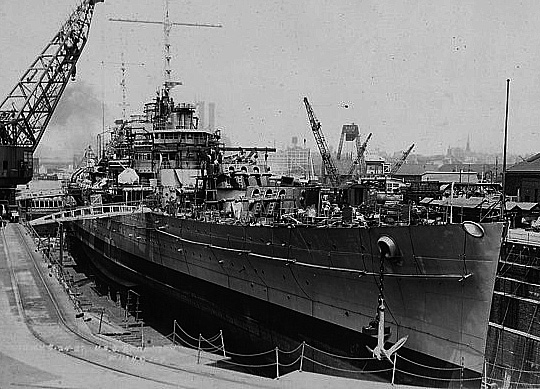
USS Brooklyn in construction. Shipyard archive – Credits navsource.org
Fire Direction
The Mark 34 director and Mark 3 radar from 1942 assured fire direction for the main artillery. The radar was later replaced by the Mark 8 and Mark 13 in 1945. The secondary battery was served by a Mark 28 (later Mark 33) fire control systems and later the Mark 4 fire control radar (later Mark 12) managed them in addition. There were also for small AA two dedicated anti-aircraft fire directors and in 1944 a Mk 51 director was to control only the 20 mm guns and in 1945 the Mark 57 and 63 directors modified for night fire.
Onboard aviation
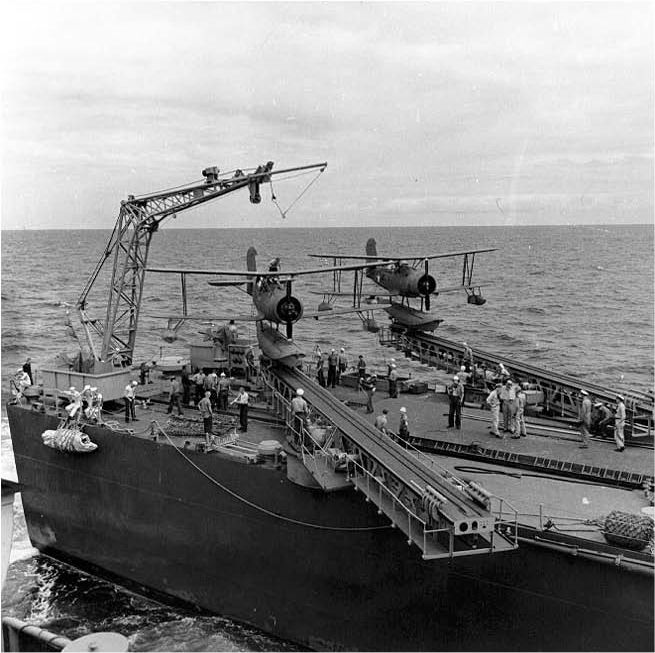
SOCs on a Brooklyn class light cruiser’s catapults, Jan. 1943 – src: http://navalmarinearchive.com/
The Brooklyns carried six planes (all stored inside the stern hangar) launched from two catapults and served by an axial crane. The crane was used both for recovery at sea, and lifting and placing them from the elevator to the catapult. Six reconnaissance planes was good for the intended role of a cruiser at a time naval radar was still in development. The cruiser’s traditonal role has been to screen for the main battle fleet as well as long-range side or rear escort, preventing any attack from other angles. The plane carried by the Brooklyn up to 1943 were the American single-engined scout aircraft Curtiss SOC Seagull.
Designed by Alexander Solla for Curtiss-Wright it became the standard for USN battleships and cruisers in seaplane configuration (it also existed with a wheeltrain). It was launched by catapult and recovered at sea landing, with foldable wings for storage. Some also operated from on carriers with a reinforced fixed wheeled landing gear. In all, 258 SOC-1 through SOC-4 were delivered, beginning in 1935.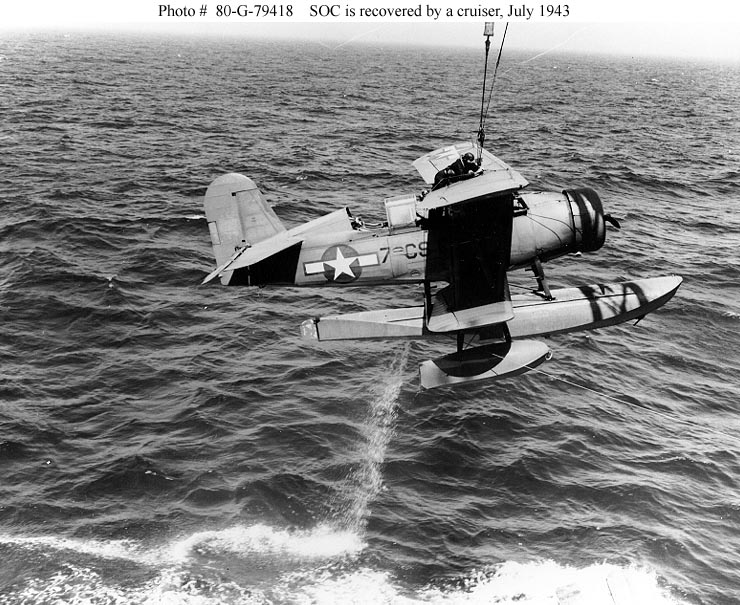
Production came to an end in 1938 and 1941 transition was made to the Vought OS2U Kingfisher, and cruisers to the SO3C Seamew, however this plan was scrapped as its engine was seen as too weak. The Seagull was propelled to 165 mph (143 knots, 266 km/h) at 5,000 ft (1,500 m) thanks to a Pratt & Whitney R-1340-18 single-row, nine-cylinder, air-cooled radial engine rated for 550 hp (410 kW). Its range was 675 mi (587 nmi, 1,086 km) at cruiser speed, it was armed by a fixed forward 0.30 in (7.62 mm) Browning M2AN and a rear gunner flexible mounted same type machine gun, and it could carry 650 lb (295 kg) of bombs for strafing attacks. It shoukd be noted that despute the dradual introduction of better radars, recoignition of ships and fleets was still performed by seaplanes, so they stayed in use until 1945.
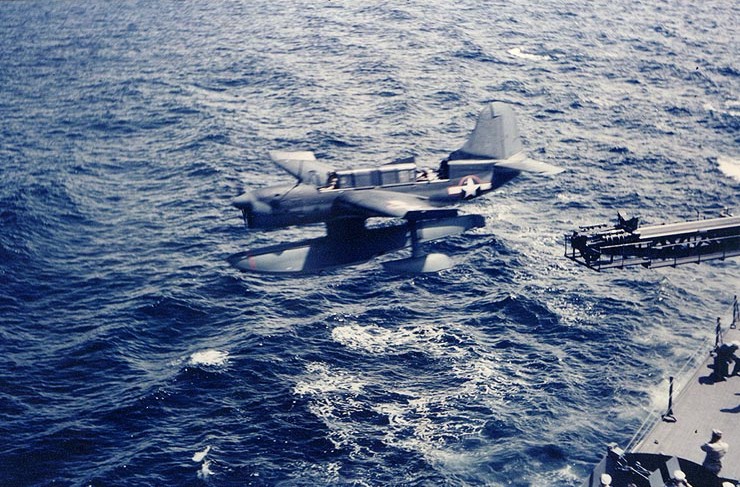
The planned successor of the Seagull, the underpowered SOC3C Seamew (here launched in 1943 from USS Biloxi) was never popular and mostly assigned to the British Fleet Air arm.
Legacy
In the end, the design of the Brooklyn had a long reach: Its principles were reused by a whole new generation of cruisers, light and heavy in the USN, and their sub-classes and derivatives: The Cleveland-class and Baltimore-class heavy cruiser to name those who count most, but also the closer near-sisters St. Louis class, Fargo-class cruiser (sub-class of the Cleveland), USS Wichita, the blueprint for the Baltimore, the sub-class Oregon City and upgraded Des Moines and Independence and Saipan-class light carriers designed on Cleveland and Baltimore hulls. In other terms, the unrestricted wartime cruisers were heavily based on the Treaty-restricted Brooklyn Class “light” cruisers.
About the immune zone:
The concept of “Immune Zone” protectio originated in the USN shortly after World War I and first applied to capital ships. It was defined as a range band within which a ship’s armor made to defeat enemy projectiles, such as a cruiser against 8-inch shells from 15,000-22,000 yards, since if closer than 15,000 yards, velocity was sufficient to penetrate the side armor, and beyongd that treshold, not enough energy until the trajectory was steep enough for it to use gravity as an accelerator and penetrate deck armor, at 22,000 yards there. The angle of impact and deck thickness were expected to defeat penetration. Fire Accuracy of course was by then too weak to ensure hits in these cases, so that form of protection was often overlooked or ignored.
Construction of the Brooklyns
The six cruisers were built at Brooklyn Navy Yard, NYC (USS Brooklyn, Honolulu), Philadelphia Naval Shipyard (USS Philadelphia), New York Shipbuilding Corporation, Camden (Savannah, Nashville, Phoenix) and Newport News Shipbuilding and Dry Dock Company (USS Boise), so these were “east coast cruisers”. They were laid down between the 12 March and 9 December 1935, launched between the 30 November 1936 and 19 March 1938 (Phoenix, CL-46) and completed between the 23 September 1937 (Philadelphia, CL-41), and 3 October 1938 (Phoenix).
Half-sisters: The St Louis class cruisers
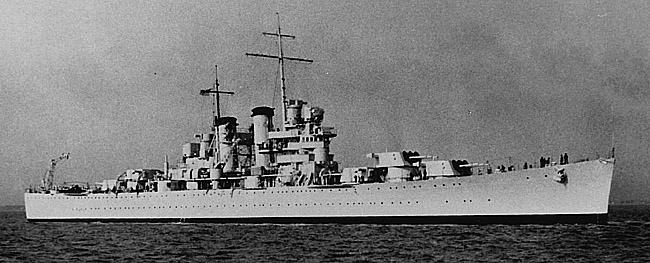
The St. Louis class were a seperate class for most authors, since the range of their modifications set them apart of the seven-ship Brooklyn class. They were fitted with new higher pressure boilersin a new arrangement, introducing a “unit system” machinery with alternating boiler and engine rooms. This was a protection measure, to prevent immobilization by a single hit. AA armament was also widely improved, with twin five-inch (127 mm) 38-caliber guns fitted. They were recoignied by the placement of their after deckhouse abaft the second funnel also.
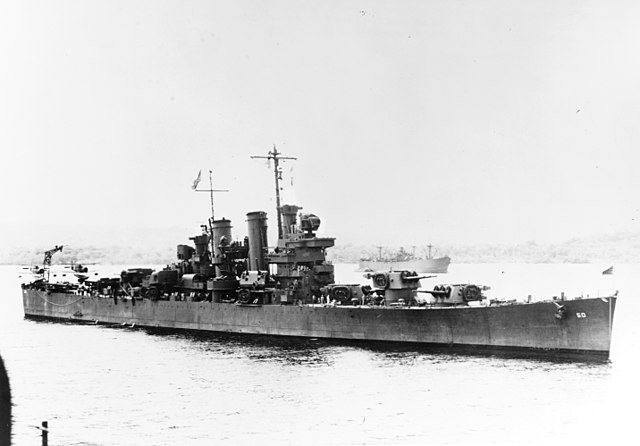
USS helena circa 1943
Both ships, USS St Louis (CL49) launched at Newport News Shipbuilding and Dry Dock Company 15 April 1938 and USS Helena (CL50) launched at Brooklyn Navy Yard on 27 august 1938 were commissioned in May and september 1939 and spent their career in the Pacific. Helena was eventually sunk in 1943 at the Battle of Kula Gulf, here remains found by Paul Allen’s research ship Petrel in April 2018. St. Louis was seriously damaged twice but survived the war. She joined her near-sister Barroso in the Brazilian Navy in 1951 (as Tamandare) and served until 1976.
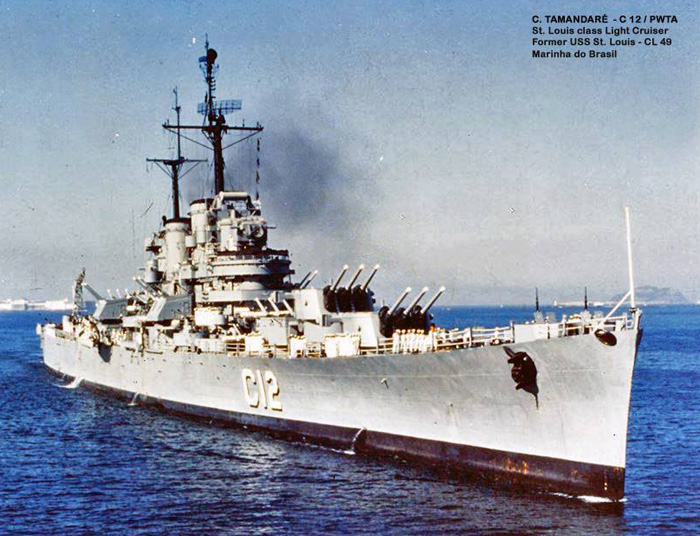
Second life: Brazilian cruiser Tamandare in the 1970s (ex. St Louis).
Career of the Brooklyns
Amthough some of these cruisers were seriously damaged in action, they all survived the war. USS Boise had her forward turret magazine hit but not blown up at the Battle of Cape Esperance (11/10/1942) as it was flooded by penetrating hits in the lower hull. USS Nashville was badly hit by a kamikaze on 13 December 1944 (Mindoro). USS Honolulu was torpedoed at the Battle of Kolombangara (12 July 1943) as USS St. Louis and later torpedoed again by a Japanese aircraft on 20 October 1944 (Leyte). USS Savannah was hit by a German Fritz X radio guided bomb in 1943, destroying her #3 turret and opening a lare hole in the bottom, but she was saved by her crew.
USS Brooklyn (CL-40)

USS Brooklyn 1939, the original look of the ship – naval encyclopedia author’s rendition
Interwar:
After her shakedown cruise off Guantanamo Bay (Cuba), USS Brooklyn crossed the Panama Canal Zone in the fall of 1938, joining Cruiser Division 8 for routine with the Pacific fleet until April 1939. She then re-crossed the canal to join the eat coast, participating in the opening of the New York World’s Fair on 30 April 1939. In May she was despatched to the Squalus disaster, off the Isles of Shoals in New Hampshir, used as a base ship during rescue operations. She joined the Pacific Fleet again, and be opresent at the Golden Gate International Exposition (18 February 1940) and patrolled along the west coast until March 1941, starting afterwards a good-will cruise with training in the the South Pacific. However, leaving Pearl Harbor in May she headed back to the west coast, joining the Atlantic Squadron and in July 1941 escorted a convoy to Reykjavík (Iceland) and making Neutrality Patrol duties until December.

USS Brooklyn in the Hudson river, 1939
WW2:

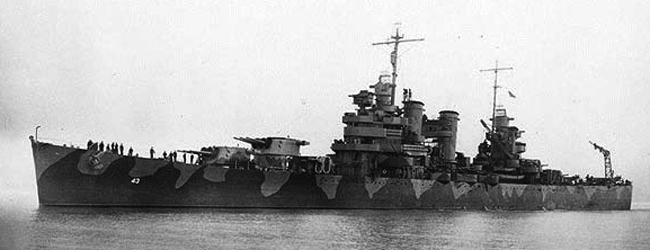
USS Brooklyn in her 1942 camouflage.
Atlantic: In April 1942 she is assigned from there to convoy escort in the Atlantic, bound to UK. On 3 September she rescued 1,173 troops onboard Wakefield, which caught fire and was abandoned.
North Africa (Operation Torch): In October 1942, she departed Norfolk for North Africa, covering the ladings from 8 November at Fedhala apparently firing by accident on the Seventh Infantry. When French warships exited Casablanca for an attack, Brooklyn and Augusta fired on the large destroyer Milan, receiving hits of small caliber fire. She also engaged the Brestois and light cruiser Primauguet, both ships later beached or sank. Brooklyn was attacked by the submarine Amazone, which near-missed. The American cruiser then silenced French artillery positions near Casablanca, being hit in return by a dud, which nevertheless damaged two of the cruiser’s guns and wounded five crewmembers.
After Casablanca, she sailed back home to the east coast on 17 November and until July 1943, made three convoy escort missions towards north africa.
Sicily and Italy:
She performed screening and fire support missions in Sicily in July and then covered the Anzio-Nettuno landings (in January – February 1944: Operation Shingle). In 23 May, she bombarded the Formia-Anzio area.
Operation Anvil Dragoon (August 1944)
After training intensively for the landings in Provence she was fully engaged on 15 August, dispensing heavy naval gunfire on the coast of southern France and stayed in mission until 21 November.
Postwar new life: O’Higgins (1947-1992)
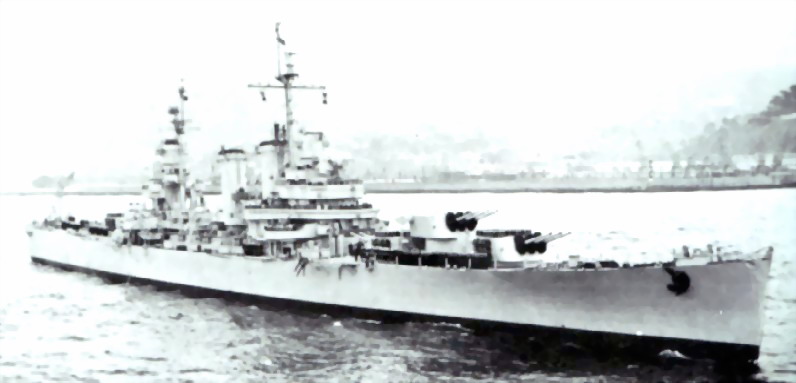
O’Higgins in 1962
heading for at New York Navy Yard, she started a comprehensive refit and overhaul from the end of November. She emerged in May 1945 only to be placed in reserve 3 January 1947. She was eventually sold to Chile on 9 January 1951, as part of the Mutual Defense Assistance Program. Renamed O’Higgins she served for 40 years, only sold for scrap in 1992. However when she was towed en route to the Indian shipbreaker, she foundered and sank off Pitcairn Island. One of her turrets was salvaged and is now displayed at Talcahuano Navy base.
USS Philadelphia (CL-41)

NE’s author’s rendition of the Philadelphia in 1942
On 3 January 1938, USS Philadelphia made her shakedown cruise in the West Indies and then retuned on the coast of Maine. She later sailed to theCharleston in April and hosted President Franklin Delano Roosevelt in the Caribbeans. She then joined Cruiser Division 8 operating on the Atlantic coast, as flagship of Rear Admiral F.A. Todd. She later joined the Pacific fleet via Panama, at San Pedro, Cal. She then departed on 2 April 1940 for Pearl Harbor and in May was in fleet manoeuvers. She then joined the Atlantic and started Neutrality Patrol operations from Halifax to the Bermuda.
The Atlantic
After the Pearl Habor attacks, she joined destroyers for ASW patrol off the coast of Newfoundland and made escorts missions to Iceland. She later joined the Task Force 22 at Norfolkd, mde a patrol near the Panama canal, and returned to NY, making patrols and escort missions to Greenock, Scotland.
Operation Torch
In the fall of 1942 USS Philadelphia was sent to Rear Admiral H. Kent Hewitt’s Western Naval Task Force assigned to General Patton to cover amphibious operations of Operation Torch in North Africa. During this time, she became flagship of Rear Admiral Lyal A. Davidson, covering the southern sector, the landing zone at Safi, Morocco, south of Casablanca. She duelled with, and silenced, the batterie Railleuse and other Vichy French coastal defences while her six planes provided precious informations. One of these also spotted and strafed, but missed a French sub (possibly Medusa) on 9 November off Cape Kantin.
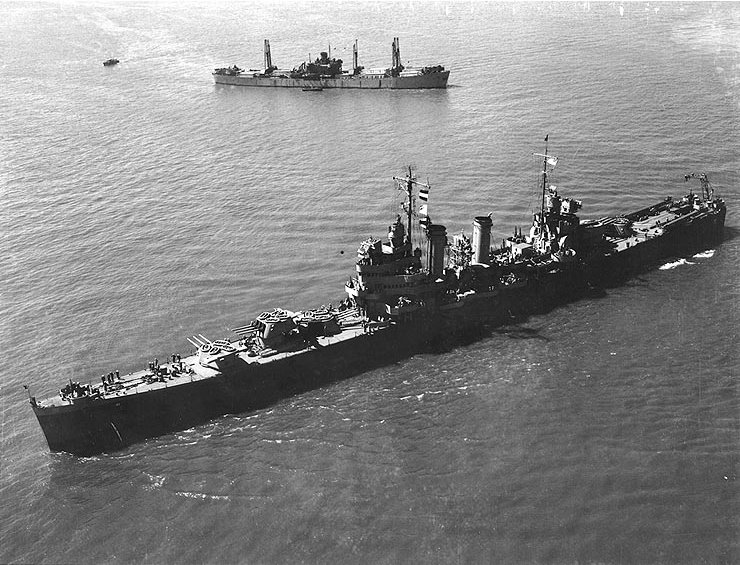
USS Philadelphia off New York 26 April 1943, front view
Operation Husky
USS Philadelphia returned to NY in 1943 and after a refit, joined Rear Admiral Alan G. Kirk’s TF 85 bound to Sicily. She sailed first to Oran, Algeria on 22 June and then departed for the landings at Scoglitti, Sicily shortly before midnight of 9 July. She provided close support to the 45th Infantry Division and later joined the group off Porto Empedocle. Ten days later she had spent her ammo and departed for Algeria to resupply. She later joined TF 88 for the attack on Palermo and entered the harbor on 30 July and bombarded axis positions there until 21 August, then returned to Algiers. In september she was sent to Salerno, spotting and destroying seven German tanks ambushed nearby. She was near-missed by a glide bomb launched by a KG 100. Off of Altavilla her AA downed about 12 attacking aircrafts. She later made an escort mission between Gibraltar and Oran and went back home.
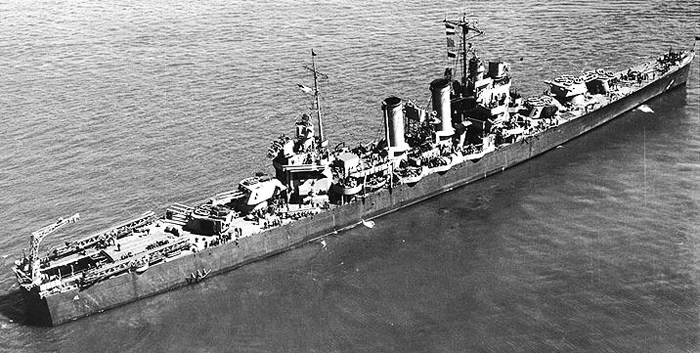
USS Philadelphia off New York 26 April 1943, stern view. Notice the two-tone dark navy blue, light grey measure camouflage.
1944: Back to the Mediterranean
After a comprehensive overhaul at New York and a short refresher training cruiser she departed for the Mediterranean to take part in the Italian campaign. USS Philadelphia supported operations at Anzio on 14 February but collided with a destroyer later (USS Laub). She was repaired at the British naval yard at Malta and later joined Admiral C. F. Bryant’s Task Group 85.12 at Taranto. She later took part of the force sailing to the southern coast of France. She was supporting the landings in the gulf of Saint-Tropez, France on 15 August (Operation Anvil Dragoon). She teamed with Texas and Nevada counter-battery fire and cleared the way for General William W. Eagles’ “Thunderbirds” (45th Army Infantry Division).
After resupplying at Propriano, Corsica on 17 August, she was back to assist the Free French Forces in taking Toulon. After gunfire support off Nice she sailed to Naples.

USS Philadelphia 1944, with the two-tones livery
1945: Philadelphia’s last campaign
Back to Philadelphia Navy Yard in November 1944, she was overhauled a second time (better radars, more AA and many other modifications) and made a refresher cruise in the West Indies. She then departed to Norfolk, Virginia on 4 June 1945 and then joined the presidential escot to Antwerp, Belgium in July 1945 to the Potsdam Conference. She then was posted in Plymouth for the convoy back and in August rendered honors to King George VI during his visit. She was back on 7 August to Norfolk, Virginia and departed again for Southampton, arriving on 6 September and returnng to Narragansett Bay with former German liner Europa in 26 September. She made afterwards several back and fort mission to Le Havre, re-embarking troops demobilized after the German capitulation and from the occupation Forces.
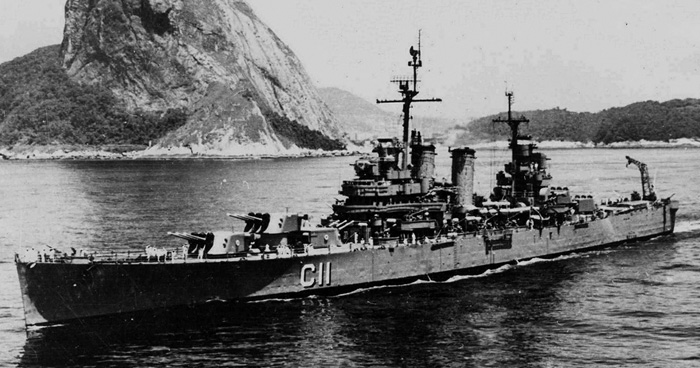
As the Brazilian cruiser Barroso in the 1960s
1947-74: New life as Barroso
Decommissioned in the Philadelphia Navy Yard on 3 February 1947 and stricken she was later sold to Brazil on 9 January 1951 after the Mutual Defense Assistance Program and served with the Brazilian Navy as C-11 Barroso until 1974.
USS Savannah (CL-42)
After a shakedown cruise to Cuba and Haiti in June 1938, and new trials off Rockland, Maine, USS Savannah made her first transatlantic cruise to Portsmouth on 4 October at the time of the Munich crisis. She made exercises back in US waters on the Caribbean Sea, visited Savannah, Georgia and then crossed the Panama Canal top join the pacific fleet in the summer of 1939, San Diego and Long Beach. She was in Pearl Harbor on 21 May 1940. But with war developments she came back to Boston via Cuba, on 17 June 1941. She then started her netrality patrols in the north and south atlantic with Cruiser Division 8 until December, escorting also the aircraft carrier Wasp.
Savannah Atlantic’s campaign
On 12 January 1942 USS Savannah operated in the south Atlantic, sailing from Recife, Brazi, as an escort to the aircraft carrier Ranger patrolling the Atlantic Ocean north of Bermuda and tracking Vichy French ships sailing to Martinique, such as the cruiser Jeanne d’Arc and aircraft Carrier Béarn. She was back to Boston Navy Yard and then joined the Cheapeake bay fleet assembled to take part in the landings in North Africa.
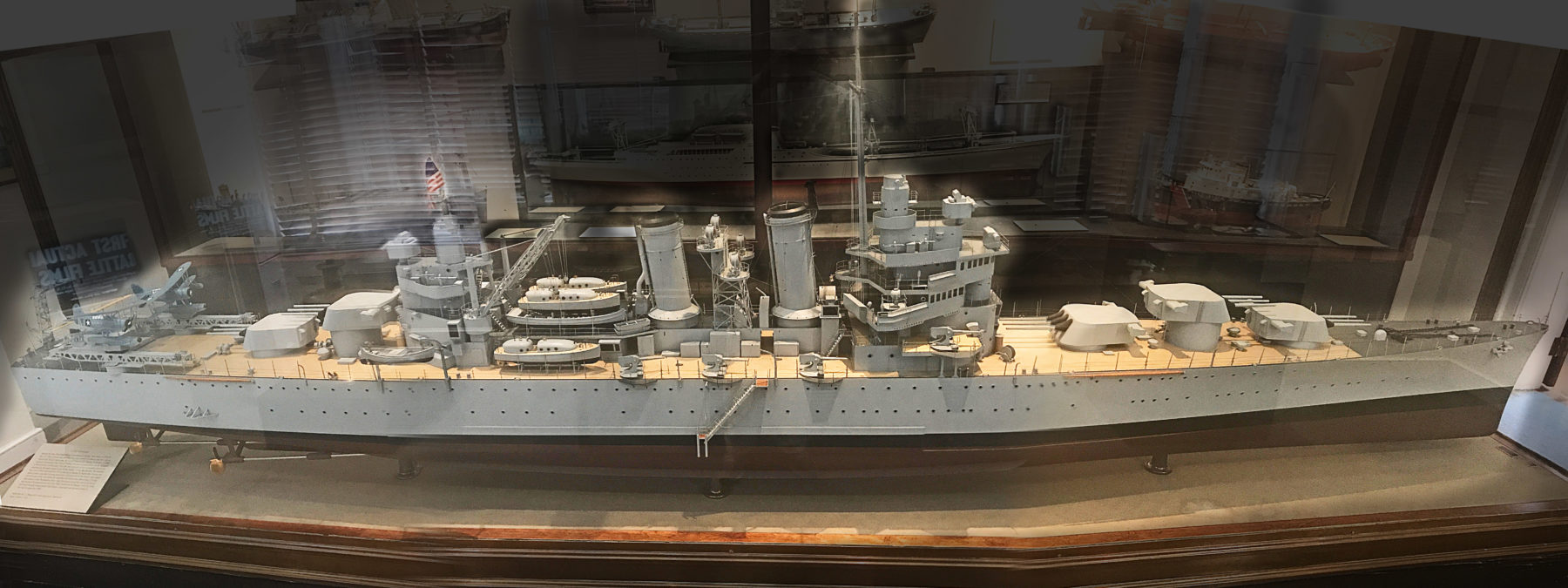
Super HD photo of the USS Savannah as built, shipyard model.
Operation Torch
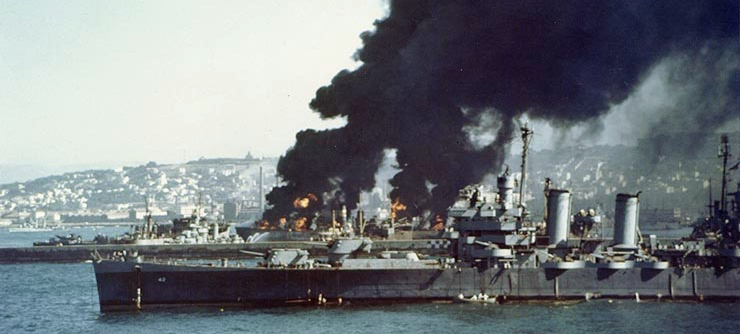
Under command of Leon S. Fiske, Savannah joined Admiral H. Kent Hewitt’s Western Naval Task Force bound for Morocco. This first wave was to land 35,000 Army troops and 250 tanks on trhree beaches. The American cruiser provided fire support all along the operation, shelling coastal defences when spotted as part of the Northern Attack Group (Rear Admiral Monroe Kelly) on 7–8 November 1942. The troops she supported attacked and took Mehedia, Port Lyautey and two airfields. She neutralized batteries near the Kasbah, and attacked ans silenced guns of the fortress of Kasbah. For the first time in history perhaps, Savannah’s own reconnaissance Curtiss Seagulls started bombing Vichy French tanks columns with… depth charges that has been reset to explode on impact. She also greatly helped in close support an infantry attack on Wadi Sebou and combined her planes attacks and gunfire to clear off Rabat Road. On 11 November the fight was over and she headed for home. Until 28 March 1943 she took part in patrols in the south Atlantic, helping capture the German steamer Karin.
Operation Husky
After ferrying troops to Oran from Norfolk on 10 May 1943, Savannah took part in the difficult amphibious landings on the southern coast of Sicily near Gela. In support of numerous coastal batteries and ambushed AT guns and mortar position, there was the backup of the elite German Hermann Göring Division. She provided cose support to the 1st Infantry Division’s Rangers but lost three planes, shot down by the Luftwaffe. She later knocked out several tanks but stopped firing as infantry positiosn became too close to the enemy. She however helped the Army Rangers in repelling an Italian infantry attack. She also shelled the well-defended hill town of Butera, sailed down towards Algiers for resupplying and returned to help 7th Army’s drive along the eastern and northern coasts of Sicily, later entering Palermo.
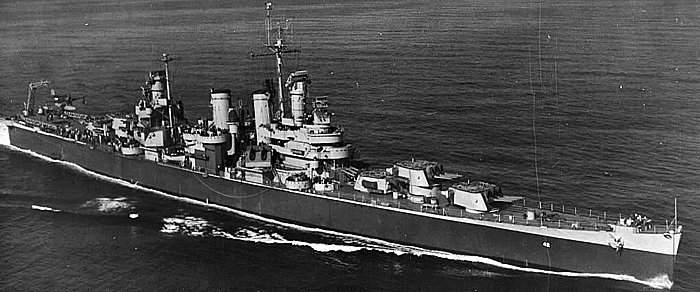
USS Savannah in 1944
Salerno
Leaving Mers-el-Kebir (Algeria) on 5 September 1943, she was part of the Southern Attack Force attacking Salerno Bay, attacking German positions, and destroying a railroad artillery battery. Se was the first American cruiser to attack the axis in Italy. She was however soon attacked by a a radio-controlled Fritz X PGM gravity bomb launched by the KG 100 Dornier 217K2. The P38 Lightning missed both the bomber and the bomb and Savannah took a severe hit: The bomb pierced the turret roof of Savannah’s No. 3 gun turret. It penetrated three decks before ending (and exploding) in the ammunition-handling room. For 30 minutes fierce fighting between safety crews and fire led to nothing. This explosion also opened a hold in her keel. She was however saved and reached Malta for long repairs. She emerged only to sail on 7 December 1943 to the Philadelphia Naval Shipyard and was there completely overhauled and modernized. She was later the only ship of the class to receive additional bulges and twin 5in/38 guns and Mark 37 directors. Afterwards, she was back in operations on 4 September 1944 but was not sent to any “hot” sector for the remainder of the war. She was eventually decommissioned on 3 February 1947, not resold to a south American navy.

USS Nashville (CL-43)
After her shakedown cruise on 19 July 1938 for shakedown in the Caribbean, USS Nashville started a goodwill tour to Europe. After Cherbourg, she joined Portland and departed back to Brooklyn with $25,000,000 in British gold bullion aboard. On the spring of 1939, she carried American representatives to the Pan American Defense Conference in Rio de Janeiro. Afterwards she crossed the canal and joined the pacific fleet for two years of operations. In February 1941 she was assisting the mission to bolster the defence of Wake island. She was also committed in the Neutality patrols in the Atlantic from August to December 1941 and after Pearl harbor, was sent to the Pacific again, after a serie of convoy escorts from the Bermuda to Iceland.
Nashville closer to Japan
probably her most daring feat of the war, USS Nashville was attached to the secret “Shangri-La” task force bound to Japan, carrying the B-25 bombers of col. Doolittle onboard USS Hornet. On 13 April, she joined Vice Admiral William F. Halsey Jr. composite fleet north of Midway Atoll, and sailed for Japan. At about about 1,000 mi (1,600 km) away from Japan, on 17 April, the destroyers broke off, because of the lack of fuel, and Nashville prepared for the last 500 miles “mad dash”. They were spotted however in 18 April by a Japanese picket boat (later sunk by USS Enteprise’s planes), and the Hornet had to launch her 16 modified bombers prematurely, 150 mi (240 km) too short. As the result, they raided the intended targets but missed the coast of China for many, crashing at sea;
1942-44 Pacific campaign
USS Nashville became the flagship of Task Force 8 (TF 8) bound to defend the Alaska and the Aleutians. She departed from Dutch Harbor, Alaska on 26 May and departed for Kodiak. She joined a force comprising USS Phoenix, USS Honolulu, two heavy cruisers and 6 destroyers, which were attacked by Yamamoto’s diversionary force planes, but were unable to replicate due to the heavy fog. Howevr after the defeat at Midway, the Japanese departed and left the Attu and Kiska Islands without support. The fleet retook the islands and Nashville provided close support.
The cruiser later joined the Fiji Islands on 24 December, and became the flagship of the fleet at Espiritu Santo (New Hebrides, TF67). She escorted troopships to Guadalcanal, and with her sister ships destroyed the Japanese air base at Munda on the night of 4 January 1943 and later took part in the campaign of Kolombangara and New Georgia. She suffered a fatal accident, after a powder charge explosion which destroyed one of her forward turrets. She sailed back for repiars at Mare Island Naval Shipyard and was back in action in New Guinea and the Admiralty Islands from October 1943. She also took part in the operations at Wake Island (April 1944) Hollandia, Tanahmerah Bay, Aitape, and Biak.
She later took part in the oprations of Mac Arthur at Morotai, on the Dutch East Indies in mid-September 1944. She also supported the assaults on Leyte Island on 20 October. However on 13 December, she was struck by a kamikaze off Negros Island. Her midships area was set ablaze and she had 133 killed and 190 wounded. She however continued to provide a fierce AA fire and was later sent to Puget Sound Naval Shipyard after several stops en route, arriving on 12 January 1945. She emerged in april 1945, and later became the flasghip of TF 74 at U.S. Naval Base Subic Bay in May, Nashville became the flagship. She took part in the operations in Borneo Makassar Straits, Dutch East Indies and her last wartime operation was to intercept a Japanese convoy off Indochina.
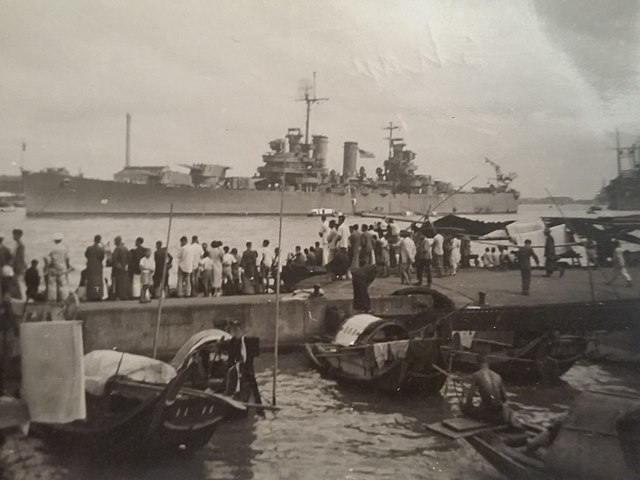
USS Nashville in the Yangtse River in October 1945.
She later took part in the Operation Magic Carpet and was decomm. on 24 June at Philadelpia NyD. Resold to Chile on 9 January 1951 she became the Capitan Prat (CL-03) and was renamed in 1982 Chacabuco until her retirement in 1985.
USS Phoenix (CL-46)
She made her shakedown cruise from the Port of Spain, Trinidad and then toured South America, stopping along the way at Santos (Brazil), Buenos Aires, Montevideo, and San Juan (Puerto Rico). She was later based at San Pedro, California. And returned for western patrols between June 1939 and April 1940. USS Phoenix was present in Pearl Harbor during the attack. She was then anchored north east of Ford Island, Solace. She escaped, unharmed, and joined a the cruisers St. Louis, Detroit and destroyers searching for the Japanese carriers, without success. She then made two convoys back and fort to the US.
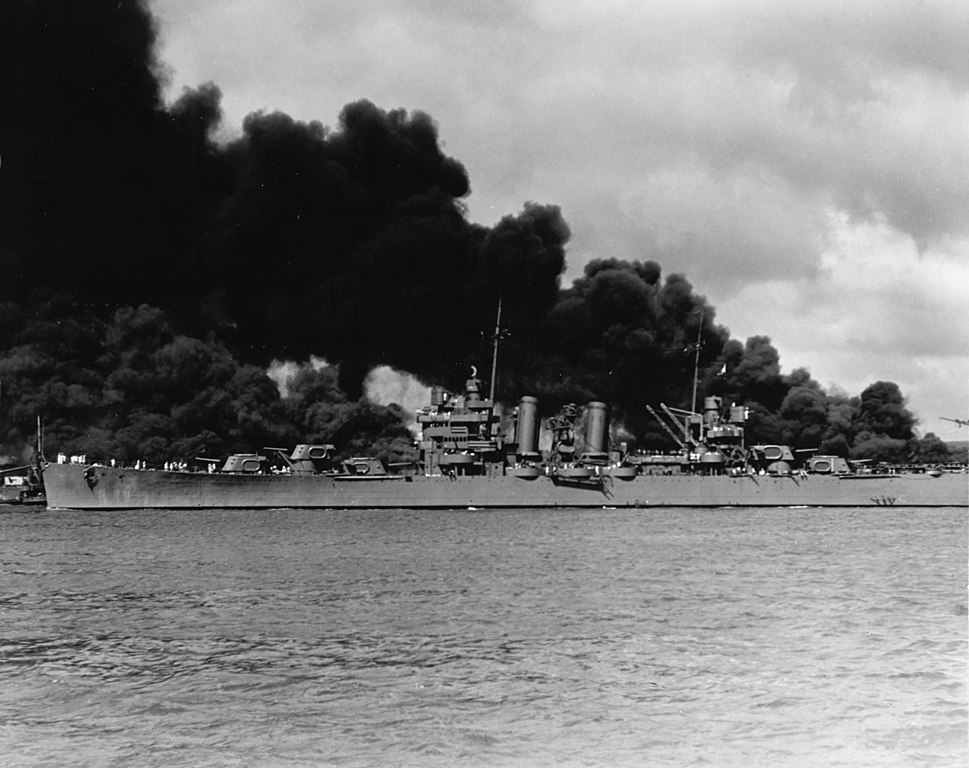
USS Phoenix at Pearl Harbor, 7 December 1941
Australia and Java
She later escorted the “Suva” large convoy to Australia, carrying many crated planes for the defence of Philippines and Java along the way. She became fir a short time naval HQ of MacHarthur for the Southwest Pacific Area Command and United States Army Forces in Australia, making trips between Australia and Java. She also made a mission to Colombo, Ceylon with troops and supplies. However the mission was a failure, planes were never delivered, the Langley was sunk and the Battle of the Java Sea wipped out the meagre ABDA force. She was back at Fremantle on 5 March 1942.
New Guinea and Admiralty islands campaigns
She participated in Operation Liliput commanded by Joseph R. Redman, with Task Force 44, late 1942, escorting convoys in and out, south of New Guinea. After a trip back home to ferry Secretary of State Cordell Hull to Casablanca she returned to the 7th Fleet in the south pacific. She was back in operations in New Guinea and the Admiralty Islands, helping the assault on Los Negros Island on 29 February 1943. She also bombarded Hauwei Island with Phoenix, Nashville, and HMAS Shropshire ad then cobvered the assault on Hollandia, pounding especially Wakde Island. She also covered an amphibious assault on Biak Island. She was attacked by Japanese fighter bombers, repelled them but took a severe near-hit, leaking considerably. She also repelled a more severe attack of low-flying torpedo bombers. She later covered the assault on Noemfoor Island on 2 July. She also joined Boise, Nashville, HMAS Shropshire and HMAS Australia in the assault of Morotai (Molucca Islands) on 15 September.
USS Phoenix (CL-46) underway at sea in 1944 with her blended camouflage (the darker bands had gradual borders).
The Philippines campaign
Phoenix joined the Close Covering Group and covered the beached on 20 October 1944, especially for the 19th Infantry Regiment. During the battle of Leyte Gulf, USS Phoenix was part of Rear Admiral Jesse Oldendorf’s group. She destroyed the Japanese Southern Force at the battle of Surigao Strait, notaby firing four spotting salvoes, and shelled with her 6-inch batteries the Yamashiro during the fateful night which saw her sinking after, while Fusō and three destroyers were later destroyed as well as Mogami by planes.
On 1 November 1944, she was attacked by a dozen Japanese planes, and USS Claxton was hit by a kamikaze while Phoenix’s own 5 in (130 mm) guns destroyed or damaged several of them. About 13:40, USS Abner Read was also badly hit when a second wave came and scored more hits but Phoenix shot down another plane, before being attacked by five more on 5 December, shooting down two and another Kamikaze five days later. During all these attacks the cruisers only suffered one wartime fatality;
However her luck turned during an assault off Mindoro on 13 December when she was struck by a Kamzikaze. On 15 December she assisted the landings, and helped secured the South China Sea while preparing the attack on Luzon. However en route to Lingayen Gulf she was torpedoed by a Japanese midget submarine, but dodge her salvo. The midget was later forced to surface by USS Taylor, rammed and sunk.
Later the cruiser also participated in the battled of Bataan and Corregidor (13–28 February 1945) and assisted minesweepers of Balikpapan, Borneo, 29 June-7 July 1945, also dealing with coastal guns. She was en route to Pearl Harbor when Japan capitulated. She joined the Atlantic fleet and was decommissioned on 3 July 1946.
As ARA General Belgrano (1951-82)
This new career would be too long to se in detail, but under the same assistance program, USS Phoenix joined the Argentine fleet, duly modernized until 1956 as General Belgrano. In 1982 she was still active, after being modernized in 1967-68 with new Dutch radars and British Sea Cat AA missiles. She was in mission bound to the Falklands for the Argentine fleet when spotted and torpedoed on 2 May 1982 by the British attack submarine HMS Conqueror.
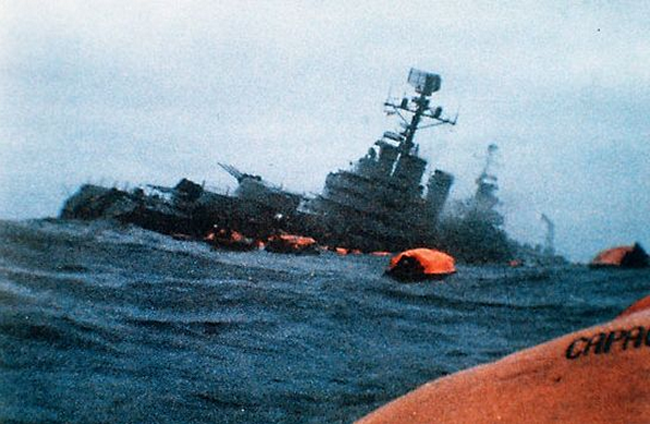
ARA Belgrano sunk in 1982, as seen from a lifeboat.
USS Boise (CL-47)
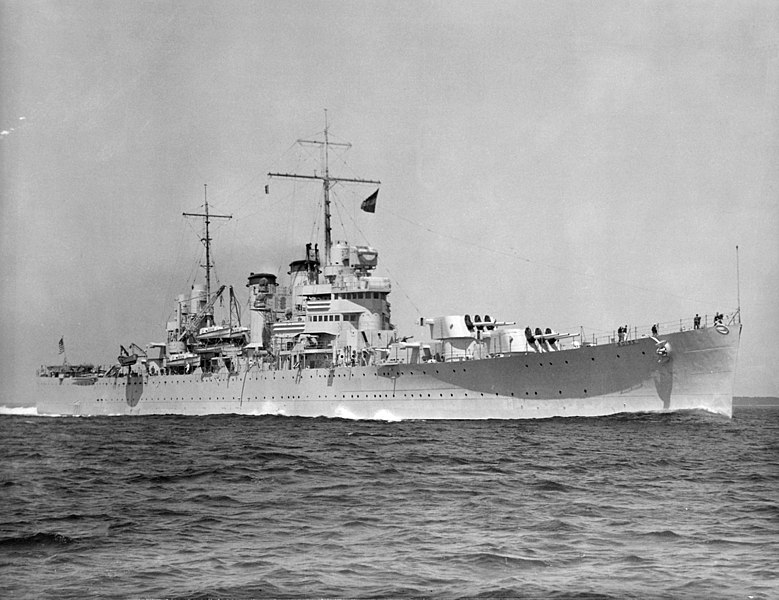
USS Boise on trials, 1938
Boise started her shakedown cruise in february 1939 from the liberia and up to cape town in south africa she joined the cuiser division 9 based at San Pedro cal.
She also operated from hawaii and escorted a convoy to the philippines.
South Pacific campaign:
On 8 december 1941 she was anchored off cebu island. she joined task force 5 in the australian waters under rear admiral glassford escorting dutch ships to surabaya.
On 21 january 1942 however she struck an uncharted shoal. She sailed to columbo, bombay and at last Mare Island NyD for final repairs and was back to pearl harbor to take part in the summer 1942 campaign fir a dummy operation to honshu around the sampan line.
She escorted a convoy to New Hebrides and in september was supporting operations at guadalcanal. She took part in the battle of cape esperance 11 to 12 october 1942. Boise was hit by a japanese cruiser at 7000 yards and three turrets were out of action with about 107 dead. Her commander “Mike” Moran earned the navy cross during the campaign.
Mediterranean campaign:
The cruiser was back to the philadelphia navy yard for an overhaul and extensive repairs. She was back in action in the mediterranean from algiers and was involved in support missions at the battle of gela in sicily. she also took part in the assault on taranto and salerno. In november she was back in the pacific arriving at milne bay, new guinea on 31 December.
She took part in early 1944 until september to the operations on northern new guinea, at madang, humbolt bay, wakde, samar and toem, biak, noemfoor, cape sansapor, and the occupation of morotai.
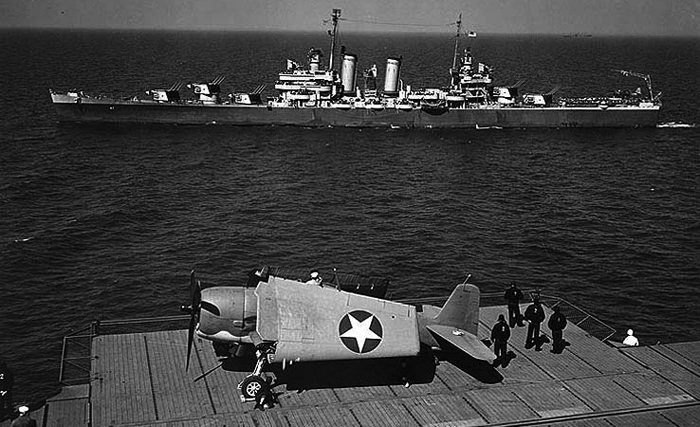
USS Boise off Yorktown, May 1943
Philippines campaign:
Uss boise also took part in the battle of leyte in october, the battle of surigao strait, where she exited unscaved. She later covered aldo the operations around the lingayen gulf and later she covered the operations of luzon. she also took part in the bataan corregidor assault, the landings at zalboanga and sailed later to take parti in april may 1945 to the operation at borneo and Tarajan.
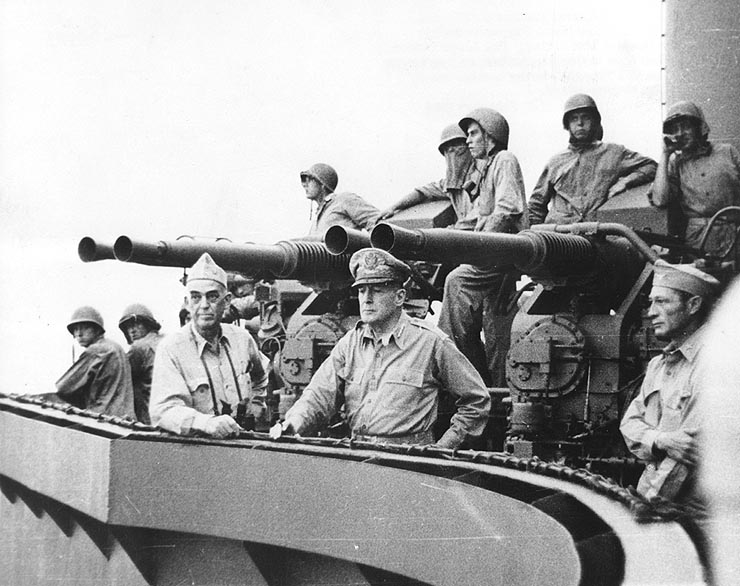
Vice-Admiral Kinkaid and General MacArthur on board USS Phoenix 28 February 1944
In june 1945, she carried general MacArthur in a 3500 miles tour of the pholippines and borneo and back to san pedro for a refit which lasted after the end of the war. in october she was in new york where she she was decommissioned in july 1946.
As ARA Nueve de Julio (1951-78):
Uss boise was kept in reserve to be resold in january 1951 to the argentine navy. she was renamed ARA nueve de julio. At that time, uss Phoenix has been renamed Diecisiete de Octubre (later general belgrano). She took part in the revolution libertadora in 1955 and the next year collided with her sister ship. She was eventually decommissioned in 1978 in texas. In total she earned 11 battle stars during her pacific campaign.

USS Boise off NY in 1945
USS Honolulu (CL-48)
Uss honolulu made her shakedown cruise in england and sailed for exercises in the caribbean and joined in june 1939 the pacific fleet operating off long beach under Captain Oscar Smith. She was anchored at Pearl harbor during the attack but suffered only minor hull damage from a near miss. She sailed to San Francisco on 12 January 1942, as a convoy escort and went on in these missions in early 1942 with Australia, and Samoa. She was also sent north to Kodiak, Alaska, and from there operated against the islated Japanese Garrison of Kiska in the Aleutian Islands on 7 August.
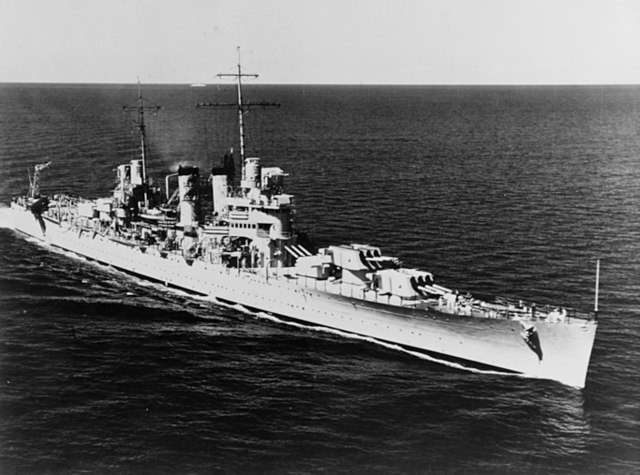
USS Honolulu 9 February 1939
Guadalcanal and the Solomon islands
Back in San Francisco she escorted another convoy to to Nouméa in the South Pacific in November. She was later based in Espiritu Santo in the New Hebrides to intervene against Japanese convoys bound to Guadalcanal. She was present during the famous Battle of Tassafaronga during the night of 30 November 1942, but escape destruction with only minor damage while other cruisers were sunk. In early 1943 she operated with the Task Force 67 against the infamous “Tokyo Express”. She also shelled Japanese positions in New Georgia. At the Battle of Kula Gulf, she destroyed a Japanese destroyer and damaged others. She was also present at the Battle of Kolombangara, firing in the famous “slot” against a Japanese cruiser of the Sendai class, and disabling her as well as repelling a destroyer. However at about 2 o’clock she received a torpedo hit on her starboard side and lost her bow. She had to pull back to Tulagi for temporary repairs and then Pearl harbor and back home at Mare Island.

Honolulu profile in 1942
But the battle-hardened cruiser was not over with the Solomons. From 11 December 1943 she was back to Espirity Santo, and on 27 December, attacked a Japanese convoy bound to Bougainville Island. She went on in January-February on other missions against various objectived in the Solomon Islands. She covered the assault on Green Island (13 February) but retired later to took part in the Mariannas campaign.
The Marianas Islands
USS Honolulu took an active part in the the conquest of Saipan and Guam.
She engaged Japanese positions on the southeastern part of Saipan Island in early June and later was deployed northwest, this time in the hope to catch Japanese reinforcement fleet.Back to Eniwetok Atollto resupply, she returned this time for the invasion of Guam. She bombarded positions for three weeks, an retired back home at Purvis Bay, Florida Island (Solomons) on 18 August. On 6 September she took part in the operations against the Palau Islands, Peleliu and Anguar, until the end of September.

USS Honolulu (color) camouflaged by wearing Measure 32, Design 2C. This was circa in the spring of 1944, in the Solomons.
The Philippines campaign
Honolulu was sent off Manus Island, Admiralty Islands, on 12 October 1944, prepared for the invasion of Leyte. She shelled Japanese positions in Leyte Gulf from 19 October, and screened the landings. She was attacked by a Japanese torpedo plane, and while Captain Thurber skillful evaded, she was struck on the port side. She was retired and sent back to Manus Island on 29 October for temporary repairs. Just enough to sail to Norfolk in Virginia. She returned to Pearl Harbor and San Diego, and then crossed the Panama Canal to Norfolk, where she layed for the remainder of the war. Indeed she emerged only to make a shakedown cruise in October 1945, and served as a training ship in Newport, Rhode Island. Back at Philadelphia on 8 January 1946 she was decommissioned, joined the Reserve Fleet but was stricken for good in March 1959, and sold for scrap the same year.
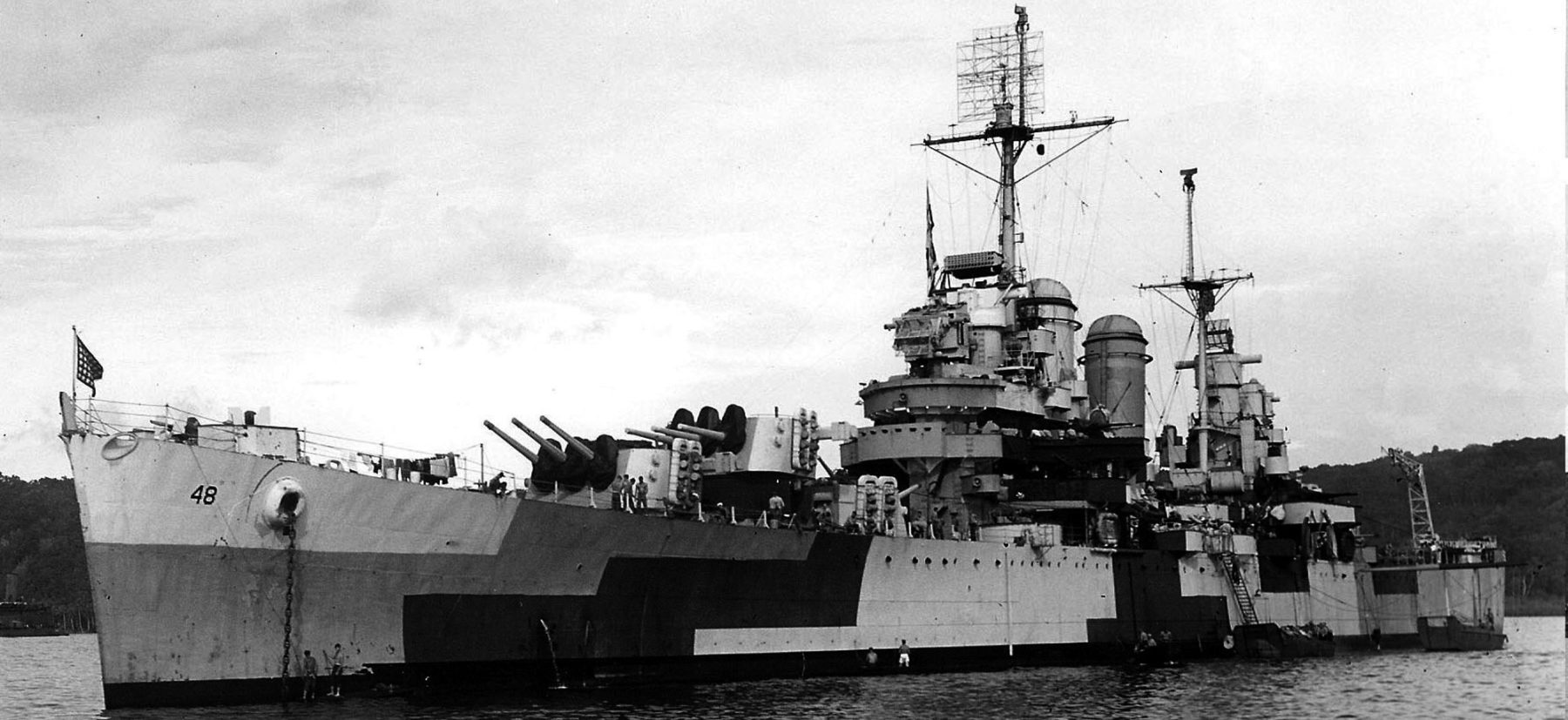
HD photo of the USS Honolulu in 1944.
Videos
Links, read more
On navalmarinearchive.com
On Navsource.org
On Coatney History
On world-war.co.uk
On aminoapps.com
On Hazegray.org
biblio links about the Brooklyns
On ww2db.com
The St Louis on globalscurity.org
St Louis class cruisers on wikipedia
The Brooklyn class on wikipedia
Specs Conway’s all the world fighting ships 1921-1947.
Dictionary of American Naval Fighting Ships, 1959: USS Savannah (CL-42)
Dictionary of American Naval Fighting Ships, 1959: USS Phoenix (CL-46)
https://forum.warthunder.com/index.php?/topic/431171-brooklyn-class-light-cruisers-cl-42-cl-46/
https://en.wikipedia.org/wiki/Brooklyn-class_cruiser
https://en.wikipedia.org/wiki/St._Louis-class_cruiser_(1938)
Brooklyn specifications 1940 |
|
| Dimensions | 185 m oa x 19m x 7m (606 x 62 x 23 feets) |
| Displacement | 9,767 long tons (9,924 t standard, 12,207 long tons FL |
| Crew | 868 |
| Propulsion | 4 shafts Parsons geared turbines, 8 Babcock & Wilcox boilers, 100,000 shp (74,570 kW) |
| Speed | 32.5 knots (60.2 km/h; 37.4 mph) |
| Range | 10,000 nmi (19,000 km; 12,000 mi) at 15 knots (28 km/h; 17 mph) |
| Armament | 5×3 × 6 in (152 mm)/47, 8x 5 in (127 mm)/25, 8 .50 cal.HMG, 4 floatplanes |
| Armor | Belt 2in (51 mm)-5 in (127 mm), turrets 1.25-6 in (152mm), CT 5 in (127mm), deck 2in (40 mm). |

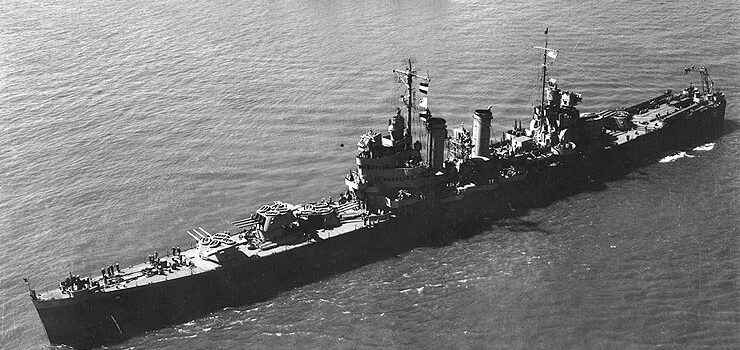

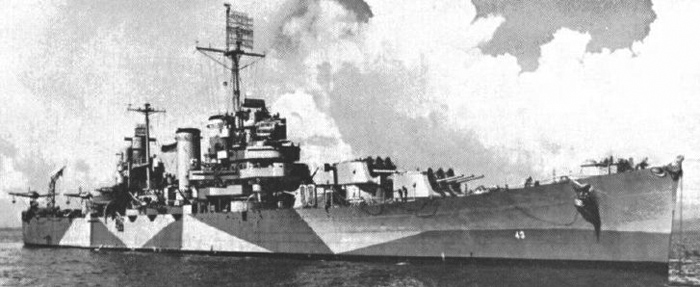


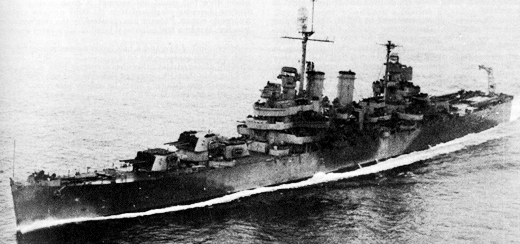
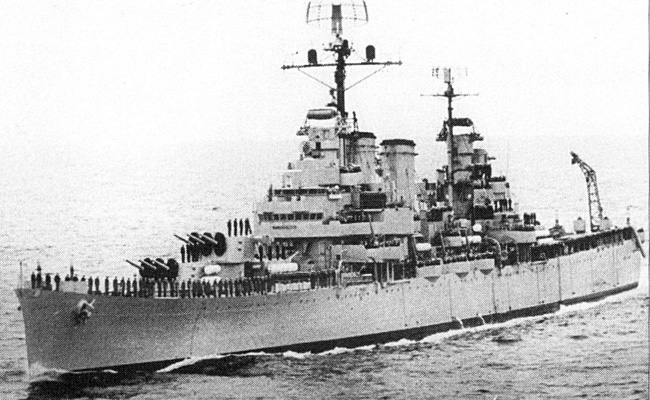



 Latest Facebook Entry -
Latest Facebook Entry -  X(Tweeter) Naval Encyclopedia's deck archive
X(Tweeter) Naval Encyclopedia's deck archive Instagram (@navalencyc)
Instagram (@navalencyc)





 French Navy
French Navy Royal Navy
Royal Navy Russian Navy
Russian Navy Armada Espanola
Armada Espanola Austrian Navy
Austrian Navy K.u.K. Kriegsmarine
K.u.K. Kriegsmarine Dansk Marine
Dansk Marine Nautiko Hellenon
Nautiko Hellenon Koninklije Marine 1870
Koninklije Marine 1870 Marinha do Brasil
Marinha do Brasil Osmanlı Donanması
Osmanlı Donanması Marina Do Peru
Marina Do Peru Marinha do Portugal
Marinha do Portugal Regia Marina 1870
Regia Marina 1870 Nihhon Kaigun 1870
Nihhon Kaigun 1870 Preußische Marine 1870
Preußische Marine 1870 Russkiy Flot 1870
Russkiy Flot 1870 Svenska marinen
Svenska marinen Søværnet
Søværnet Union Navy
Union Navy Confederate Navy
Confederate Navy Armada de Argentina
Armada de Argentina Imperial Chinese Navy
Imperial Chinese Navy Marinha do Portugal
Marinha do Portugal Mexico
Mexico Kaiserliche Marine
Kaiserliche Marine 1898 US Navy
1898 US Navy Sovietskiy Flot
Sovietskiy Flot Royal Canadian Navy
Royal Canadian Navy Royal Australian Navy
Royal Australian Navy RNZN Fleet
RNZN Fleet Chinese Navy 1937
Chinese Navy 1937 Kriegsmarine
Kriegsmarine Chilean Navy
Chilean Navy Danish Navy
Danish Navy Finnish Navy
Finnish Navy Hellenic Navy
Hellenic Navy Polish Navy
Polish Navy Romanian Navy
Romanian Navy Turkish Navy
Turkish Navy Royal Yugoslav Navy
Royal Yugoslav Navy Royal Thai Navy
Royal Thai Navy Minor Navies
Minor Navies Albania
Albania Austria
Austria Belgium
Belgium Columbia
Columbia Costa Rica
Costa Rica Cuba
Cuba Czechoslovakia
Czechoslovakia Dominican Republic
Dominican Republic Haiti
Haiti Hungary
Hungary Honduras
Honduras Estonia
Estonia Iceland
Iceland Eire
Eire Equador
Equador Iran
Iran Iraq
Iraq Latvia
Latvia Liberia
Liberia Lithuania
Lithuania Mandchukuo
Mandchukuo Morocco
Morocco Nicaragua
Nicaragua Persia
Persia San Salvador
San Salvador Sarawak
Sarawak Uruguay
Uruguay Venezuela
Venezuela Zanzibar
Zanzibar Warsaw Pact Navies
Warsaw Pact Navies Bulgaria
Bulgaria Hungary
Hungary

 Bundesmarine
Bundesmarine Dutch Navy
Dutch Navy Hellenic Navy
Hellenic Navy Marina Militare
Marina Militare Yugoslav Navy
Yugoslav Navy Chinese Navy
Chinese Navy Indian Navy
Indian Navy Indonesian Navy
Indonesian Navy JMSDF
JMSDF North Korean Navy
North Korean Navy Pakistani Navy
Pakistani Navy Philippines Navy
Philippines Navy ROKN
ROKN Rep. of Singapore Navy
Rep. of Singapore Navy Taiwanese Navy
Taiwanese Navy IDF Navy
IDF Navy Saudi Navy
Saudi Navy Royal New Zealand Navy
Royal New Zealand Navy Egyptian Navy
Egyptian Navy South African Navy
South African Navy






























 Ukrainian Navy
Ukrainian Navy dbodesign
dbodesign
Good stuff, This was well written.Check the hull numbers on the profiles .
Thanks ! Did you spot something odd ?
Hello, this photo was taken by a sailor from the Argentine Navy from a lifeboat.
Ok thanks ! Legend updated.
The Turret diagram appears to be for a Cleveland class rather than a Brooklyn. Brooklyns did not have 3 inch roofs, that was a thing for the Cleveland class. USS Savannah’s damage report for example clearly shows 2 inch STS and the available diagrams also show 2 inch.
Ok, diagram removed. If one day i could find an official cutaway…